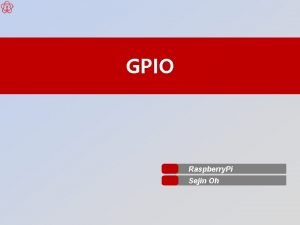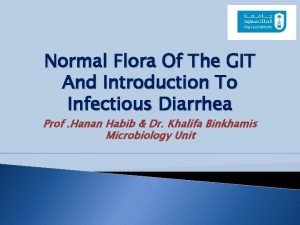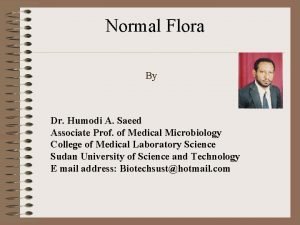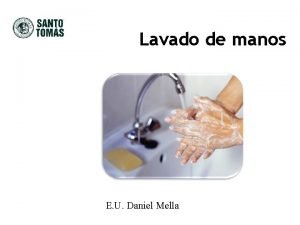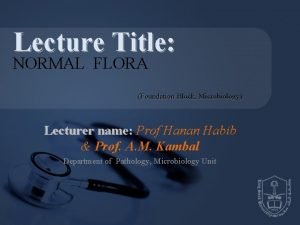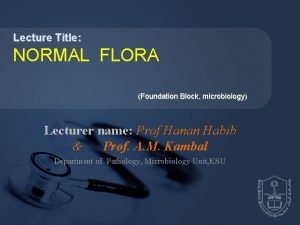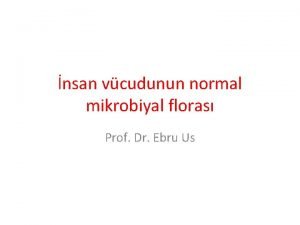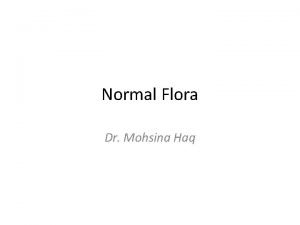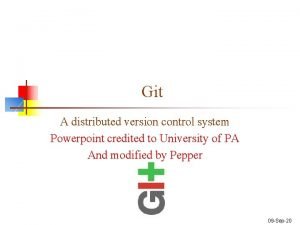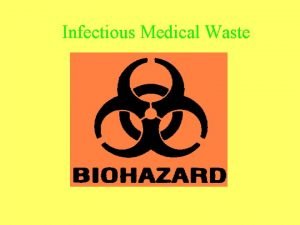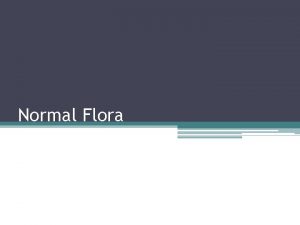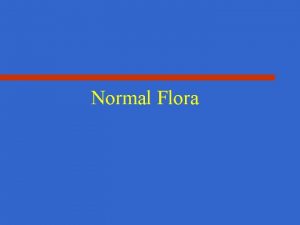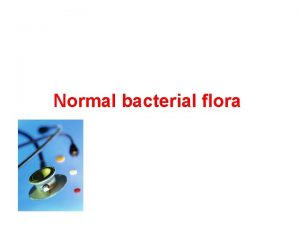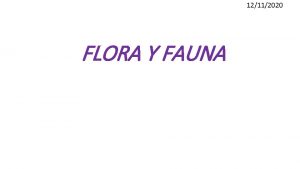Normal Flora of the GIT Introduction To Infectious














- Slides: 14

Normal Flora of the GIT & Introduction To Infectious Diarrhea Lecture objectives: ● ● ● Recall the common normal flora of the GIT. Understand the role of the normal flora of the GIT in diseases. Describe the epidemiology, risk factors & host defenses in preventing GI infections. Describe various types of acute diarrheal illnesses, the pathogens that cause them, their clinical presentation, pathogenic mechanism and prevention. Explain the pathogenesis of E. coli, Campylobacter, Yersinea & Clostridium difficile and their management. Discuss microbiological methods used for the diagnosis of common bacterial agents causing diarrheal infection. Color index: Important Doctors’ note Extra Found in Girls’ slides Found in Boys’ slides EDITING FILE

Introduction to normal flora Definition: Normal flora are microorganisms that are frequently found in various body sites in normal, healthy individuals. Constituents and number vary according to the age and physiologic status. Able to colonize and multiply under the existing condition of different body sites. Inhibit competing intruders. Have symbiotic relationship that benefit the host. Can cause disease in immunocompromised patients. Oral cavity Saliva Normal Flora of the GIT Contains mixed flora: 108 organisms/ml Stomach Empty stomach has no normal flora in health due to HCL and peptic enzymes Small intestine Very scanty except near colon. Colon of adults Virulence: Mouth Nasopharynx Stomach Small intestine Colon of adults Contains high number of flora which vary from site to site of the mouth. 1010 organisms/gm stool: ● ● >90% are Bacteroides (anaerobic), 10% other bacteria. Direct effect of diet composition. Normal flora (low virulence): Potential pathogen (carrier): - Viridans streptococci - Moraxella - Neisseria spp -Peptostreptococcus - Candida albicans - Neisseria spp - Moraxella - Viridans streptococci - Peptostreptococcus - S. pneumoniae - H. infuenzae - S. aureus - Streptococci + others from mouth - Peptosterptococcus none scanty, variable - Bacteriodes - Eubacterium - Enterobacteriaceae - Clostridium - N. meningitidis - S. pyogenes, none - Fusobacterium - Lactobacillus - Enterococcus - B. fragilis - E. coli - Pseudomonas - Candida - Clostridium (C. perfringens, C. difficile) 1

Role of Normal Flora in Diarrheal Diseases Many are opportunistic pathogens: e. g. perforation of the colon from ruptured diverticulum ➔ feces enter into peritoneal cavity and cause peritonitis ● Viridans streptococci of oral cavity enters the blood 3 and colonize damaged heart valves. ● Mouth flora play a role in dental caries Compromised defense systems increase the opportunity for invasion. Death after lethal dose of radiation due to massive invasion of normal flora. E. coli : the most common Enterobacteriacae, a facultative flora of colon followed by Klebsiella, Proteus and Enterobacter. Salmonella, Shigella and Yersinia are NOT normal flora of the intestinal tract. Some strains of E. coli, Salmonella, Shigella and Yersinia enterocolitica are able to cause diseases in the intestinal tract. Intestinal Pathogens Enterobacteriacae: Family Features • Gram-negative rods • Facultative anaerobes • Ferment glucose • Catalase positive • Antigens – O: cell envelope or O antigen ( outer membrane ) – H: flagellar (motile cells only) antigen – K: capsular polysaccharide antigen – Vi (virulence): Salmonella capsular antigen Invasive and Cytotoxic strains 1 produce inflammatory diarrhea (Dysentry) with WBCs and/ or blood in the stool. Enterotoxin-producing strains 2 cause watery diarrhea with loss of fluid. Some produce systemic illness due to spread to multiple organs such as enteric (typhoid) fever. 1. Enteroinvasive E. coli & Yersinia enterocolitica. 2. Enterotoxigenic E. coli, Enterohemorrhagic E. coli, Clostridium difficile & Staph. aureus 3. for example by brushing your teeth it may enter the bloodstream leading to endocarditis in damaged valves 2

3 Introduction to Diarrhea ● Introduction: ○ Acute diarrheal illness is one of the most common problems evaluated by clinicians. ○ A major cause of morbidity and mortality world-wide. ○ Most of healthy people have mild illness but other might develop serious squeals so it is important to identify those individuals who require early treatment. Diarrhea Stool weight in excess of 200 gm/day, or three or more loose or watery stools/day. ○ Alteration in normal bowel movement characterized by decreased consistency and increased frequency. ○ Less than 14 days in duration. ○ Definition: Etiology: Viral 70 -80% of infectious diarrhea in developed countries. Epidemiology: Classification: ● ● Bacterial 10 -20% of infectious diarrhea but responsible for most cases of severe diarrhea. Protozoan less than 10%. 1. 2 - 1. 9 episodes person annually in the general population 2. 4 episodes per child <3 years old annually 5 episodes per year for children <3 years old and in daycare Seasonal peak in the winter. Infectious Diarrhea 1 Viral or Bacterial infections, e. g. : ○ Campylobacter ○ Shigella ○ Salmonella ○ Yersinia ○ Vibrio cholerae ○ E. coli Food Poisoning 2 Staph. Aureus 3 ○ Clostridium perfringens 1 ○ Bacillus spp. ○ Traveler Diarrhea Enterotoxigenic E. coli (ETEC) ○ 1. The toxin is released within the body 2. The toxin is pre-formed in the food 3. They have a heat stable toxin, short IP (1 -6 hours), with severe symptoms in short duration. Antibiotic Associated Diarrhea Clostridium difficile. ○

Risk Factors & Clinical Presentation ● Risk Factors: Food from restaurants. Family member with gastrointestinal symptoms. Patient underlying illness & medication, low stomach acidity, cyst, spores. Abnormal peristalsis. Recent travel to developing countries. Low Immunoglobulin A (Ig. A). Antibiotics decrease the normal flora to less than 1012. (C. difficile) Median infective dose (ID 50). 1 Clinical Presentation & Pathogenic Mechanisms: Stool analysis: Symptoms: Enterotoxin mediated (I) Invasive (II) Lack of pus in the stool (no gut invasion) Pus and blood in the stool ● ● Location: Etiology: Characteris tics/Other: No fever Non-Bloody diarrhea Vomiting Abdominal cramps Fever due to inflammation Dysentery syndrome: gross blood and mucous , severe pain Small intestine affected 2 ● ● ● Vibreo cholerae Staphylococcus aureus Clostridium perfringens Bacillus cereus Some viral and parasitic infections. Some have rapid onset 4 (<12 hour if due to preformed toxin ingestion) 1. low dose ➝ higher risk or faster infection 2. causing watery diarrhea 3. they are both cyto-toxic & invasive. 4. Staph. Aureus. Colonic mucosa affected ● ● ● Shigella 3 Salmonella spp. 3 Campylobacter some E. coli Entameoba histolytica ● ● Incubation period 1 -3 days Extension to lymph nodes EHEC bloody diarrhea Entameoba histolytica 1 -3 wk 4

Campylobacter 5 Campylobacter world wide infection (especially among children) Morphology Gram-negative curved (spiral or S-shaped) Bacilli. Species C. jejuni, C. coli, C fetus. Sources Dogs, cats, birds, poultry 1, water, milk & meat. Person to person transmission can occur. Clinical Presentation Lab 2 Diagnosis ● ● ● ● Complications Treatment Incubation period: 2 -6 days Lower abdominal pain , watery or dysenteric diarrhea with pus and blood. fever in some patients. Nausea and vomiting are rare. Self limiting after 2 -6 days. Chronic carrier & outbreaks uncommon. Use transport media. Culture on CAMPY BAP media containing antibiotics. Incubate in microaerophilic atmosphere (5%O 2, 10%CO 2, 85%N) at 42°C except C. fetus 37°C Identification: Gram stain/ Culture/ Biochemical/ Serology. Campylobacter infections may lead to: 3 ○ Autoimmune disease (e. g. Guillain-Barrie’ syndrome ) ○ Extra-intestinal infections (e. g. Reactive arthritis , bacteremia, lung infection and others frequently preceded by C. jejuni infection. ) ● ● Self-limiting no need for treatment. Only in severe cases, Erythromycin or Ciprofloxacin. 1. Chicken, sometimes not directly, by cross-contamination to other food products, e. g. When you use a knife for cutting an uncooked chicken then using the same knife for other products ( e. g. vegetables). 2. by taking stool sample 3. Ascending paralysis

Escherichia Coli 6 ● Escherichia coli (E. coli): About 10 -15% of strains of E. coli associated with diarrhea. Other strains associated with extra-intestinal diseases ( septicemia, meningitis & UTI). ○ Based on virulence factors, clinical manifestation, epidemiology and different O and H serotype. ○ Morphology: ○ Gram-negative ○ oxidase -ve Bacilli Types of Diarrheagenic E. coli: 1 - Enterotoxigenic E. coli 2 - Enteropathogenic E. coli 3 - Enteroinvasive E. coli 4 - Enterohemorrhagic E. coli 5 - Enteroaggregative E. coli (E T E C) (E P E C) (E I E C) (E H E C) (E A E C) 1 - Enterotoxigenic E. coli (ETEC) Has high infective 1 dose 106 -1010. ○ Produce heat-labile toxin (LT) and heat-stable toxin (ST), each has two fragment (A and B). - LT leads to accumulation of c. AMP, which leads to hyper-secretion of fluid with no cellular injury. ○ No invasion or inflammation. ○ Characteristics Major cause of Traveler's diarrhea in infant and adult in developing countries due to consumption of contaminated food and water. - Symptoms: watery diarrhea, abdominal cramps and some time vomiting. ○ Self limiting. No routine diagnostic method required. ○ Clinical features 2 - Entero invasive E. coli (EIEC) Characteristics Clinical features Similar to Shigella spp. ( non motile, LNF 2 ) ○ Transmission: Fecal-oral route. 6 ○ High Infective dose 10. ○ Produce dysentery (Penetration, invasion and destruction). ○ Mainly seen in children. - Symptoms: Fever, severe abdominal cramp, malaise and watery diarrhea. ○ 1 - Requires a large amount of bacteria to cause infection. 2 - non-lactose fermenting.

Escherichia Coli Cont. 7 3 - Enteropathogenic E. coli (EPEC) Cause infantile diarrhea (bottle fed infants). Symptoms: > Mucus in stool but no blood. > Low grade fever, malaise, vomiting and watery diarrhea. ○ Disrupt microvilli and intestinal absorptive function. ○ Causes outbreak in hospital nurseries and day care centers. ○ Characteristics 4 - Enterohemorrhagic E. coli (E HEC) Most severe Cytotoxin : Shiga-toxin I & II (verotoxin І and verotoxin ІІ)2 (Similar to toxin produced by Shigella dysenteriae) ○ Characteristics ○ Clinical features Causes Diagnosis Other low Infective dose 0157: H 7 Hemorrhagic diarrhea, colitis and hemolytic uremic syndrome (HUS). manifested with low platelet count, hemolytic anemia and kidney failure. Symptoms: Bloody diarrhea, low grade fever and stool with no leucocytes ○ Fatal disease in young and elderly persons in nursing homes ○ ○ Undercooked hamburgers 1, unpasteurized dairy products, Apple cider, cookie dough Culture on SMAC (Sorbitol Mac. Conkey agar) ○ Vertoxin detection by immunological test ○ nucleic acid testing (NAT). ○ Management of HUS required. ○ Antimicrobial therapy not recommended. ○ E. coli other than 0157: H 7 can cause HUS. ○ 5 - Enteroaggregative E. coli (EAEC) Pediatric diarrheal disease Symptoms: Mucoid, watery diarrhea, vomiting, dehydration and abdominal pain. ○ Adhering to the surface of the intestinal mucosa ➔ Produce aggregative stacked brick ○ May resolve after two weeks or more. ○ Clinical features 1 - Why only hamburgers? Why not steak? Because steak isn’t minced so only the outer surface is exposed to the bacteria thus it will be killed even if it’s not well-cooked. Unlike hamburger which is minced beef so not only the outer surface is exposed to the bacteria even the inner parts of the beef are contaminated thus we need to cook it very well. (they used to call it the hamburger disease) 2 -vero cell are a lineage of cells used in cell culture.

Yersinia enterocolitica & Clostridium difficile Yersinia enterocolitica Morphology Epidemiology/ Sources Gram-negative Bacilli. ○ Non lactose fermenter ○ Common in Europe, USA & Canada. 1 ○ From: Cats, Dogs & Swine (chitterlings ). ○ Survives cold temperatures and associated with transfusion of packed red blood cells. ○ ● Clinical Presentation Lab Diagnosis ● ● Mesenteric lymphadenitis in children and septicemia in immunocompromised hosts. Presents with enteritis, arthritis and erythema nodosum 2. Generalized infection in adult and children 1 -5 year, usually mild but in old children and adult mimic appendicitis. Media: Cefsulodin-Irgasan-Novobiocin (CIN media) ○ Growth at 25°-30°C ○ Clostridium difficile. Morphology Cause very common Anaerobic spore forming Gram-positive Bacilli. Antibiotic associated diarrhea (ampicillin, cephalosporins & clindamycin): ○ Antibiotic used during the last 8 weeks (community acquired) ○ Hospital stay for at least 3 days (hospital acquired). ○ Cultured from inanimate hospital surfaces Transmitted from person to person via fecal-oral route. Disruption of the endogenous bacterial flora of the colon. ○ Produce toxin A (enterotoxic & cytotoxic effects) and B (cytotoxic) that can bind to surface epithelial cell receptors leading to inflammation, mucosal injury & diarrhea. ○ Pathogenesis ○ Clinical Presentation Pseudomembranous colitis: - Patient presents with fever, leukocytosis, abdominal pain and diarrhea. - Pseudomembrane can result (neutrophils, fibrin, and cellular debris in the colonic mucosa) and toxic megacolon. Lab Diagnosis Direct toxin detection from stool by enzyme immunoassay (EIA), or nucleic acid testing (NAT). Treatment Metronidazole ± oral Vancomycin (Drug of choice) and supportive treatment. 1. Chitterlings are a prepared food usually made from the small intestines of a pig 2. Erythema nodosum is a type of skin inflammation that is located in a part of the fatty layer of skin. 8

Clinical Characteristics & Lab diagnosis 9 Selected Clinical and Epidemiologic Characteristics of Typical Illness Caused By Common Foodborne Pathogens: 1 Pathogen Typical Incubation Period Duration Typical Clinical Presentation Assorted Foods Salmonella species 1 -3 Days 4 -7 Days Gastroenteritis Undercooked eggs or poultry, produce Campylobacter jejuni 2 -5 Days 2 -10 Days Gastroenteritis Undercooked poultry, unpasteurized dairy products E. coli, Enterotoxigenic 1 -3 Days 3 -7 Days Gastroenteritis Many foods Shigella species 1 -2 Days 4 -7 Days Gastroenteritis Produce, egg salad Listeria monocytogenes 2 2 -6 weeks Variable Gastroenteritis, meningitis abortion Deli meat, hotdogs, unpasteurized dairy products Bacillus cereus 1 -6 hour <24 hour Vomiting, Gastroenteritis Fried rice, meats Clostridium botulinum 3 12 -72 hour Days-months Blurred vision, paralysis Home-canned foods, fermented fish Staphylococcus aureus 1 -6 hour 1 -2 Days Gastroenteritis, particularly nausea Meats, potato & pork, unpasteurized dairy products. Yersinia enterocolitica 1 -2 Days 1 -3 weeks Gastroenteritis, appendicitis-like syndrome Undercooked pork, unpasteurized dairy products. ● Lab diagnosis of diarrheal diseases due to bacterial causes 4: Stool specimen: - Microscopy: 5 ○ - For the presence of polymorphs or blood may help. Culture: On selective media to inhibit the growth of normal flora in stool for Salmonella, Shigella & Campylobacter. ○ Culture for Vibrio cholerae, EHEC or Yersinia if suspected. ○ - Toxin assay: ○ - if C. difficile toxins is suspected. Molecular Testing 1. Click HERE for a cool graph from Kaplan. 2. gram +bacilli , causes meningitis in neonates and immunocompromised 3. clostridium botulinum Type A is the most fatal toxin in the world 4. most of them are self limiting but in cases of immunocompromised patients we do lab diagnosis 5. only if we suspect shigella; there will be increase in WBC

Dr’s Notes Dr. Khalifa’s notes: Pathogenesis is very imp may come as SAQ! GI flora: ● Most GI flora can be potential pathogen in the right situation, e. g. Strept. viridans which is flora of the oral cavity can cause infective endocarditis. ● Some organisms are NOT consider as normal flora such as (Salmonella, Shigella, & Yersinia), their presence can potentially cause infection. Clinical Presentation of GI infections: ● Bloody / Watery Diarrhea. ● Abdominal pain / cramp. ● Vomiting. Diarrheal illnesses: ● Viral infections are the most common cause. ● Risk factors ○ Traveling to developing countries. ○ Anatomical abnormalities of GIT ○ Antibiotics, which ↓ the normal flora of the colon leaving colonized C. difficile, & infection will be easier by any other pathogen. ○ Food poisoning (e. g. undercooked chickens, or Hamburgers). ○ Decreasing the acidity of stomach. Campylobacter: ● Gram negative bacilli, spiral shape. ● Invasive cause of diarrhea. ● One of the most common cause of diarrhea. . ● C. P: Lower abdominal pain, & usually watery diarrhea. ● Risk factor for Guillain-Barrié syndrome & extra-intestinal infections (e. g. reactive arthritis ). ● Lab diagnosis: Needs microaerophilic environment & special media to growth (CAMPY BAP). ● Usually self-limiting , & treatment only in severe cases. Enterotoxigenic E. coli: ● Similar to vibrio. ● Enterotoxin mediated ; heat-labile toxin (LB) leads to accumulation of c. AMP which lead to watery diarrhea. ● Main cause of Traveler’s diarrhea. ● Has high infective dose. ● Usually self-limiting. Enteroinvasive E. coli: ● Gram negative bacilli, Non-lactose fermenting & Non-motile (similar to shigella spp. ). ● Invasive mechanism. Enterohemorrhagic E. coli: ● One of the most important type of E. coli ● Cytotoxin mechanism; shiga-toxin I & II ● Can cause bloody diarrhea. ● Low infective dose, note that there are 3 low infective dose bacteria: EHEC, Shigella and Salmonella. ● & Can cause Hemolytic Uremic Syndrome (HUS) = low platelet count, hemolytic anemia & kidney failure. ● Undercooked hamburger , or cross-contamination to other food e. g. lettuce ● Lab diagnosis: it’s sorbitol-fermenting so we use; Sorbitol Mac. Conkey agar (SMAC). ● NO antibiotics therapy is recommended; because it might increase the risk of HUS. Yersinia enterocolitica: ● Not common, related to pig products. ● Invasive cause, & can cause reactive arthritis, & clinically it mimic appendicitis. Clostridium difficile: ● Anaerobic Gram-positive species of spore-forming bacteria → can survive in environment. ● Enterotoxin mediated. ● Antibiotics associated diarrhea. ● Can cause severe diarrhea → can leads to death if not treated. ● When it infects the GIT, it either causes an immediate disease or it can colonize the colon until the host exposes to antibiotics ● Causes Pseudomembranous colitis and Toxic megacolon. ● Can cause watery or bloody diarrhea. ● Lab diagnosis: we look for toxin gene by Nucleic Acid Test (NAT) or the toxin itself using Enzyme Immunoassay (EIA). ● Treatment: oral Vancomycin(drug of choice) 10

Dr’s Notes Cases By Dr. Khalifa: CASE 1: A patient presented with lower abdominal pain, gastroenteritis symptoms, low grade fever with watery/bloody diarrhea, recently he went to a BBQ party and ate chicken. Culture of organism showed Gramnegative curved bacilli. Q 1: What’s the most likely organism? Campylobacter jejuni Q 2: How is it transmitted(sources)? Undercooked eggs or poultry, Meat. Q 3: Mention 2 complications. 1 - Guillain-Barrie’ syndrome 2 - Reactive arthritis Q 4: How do we diagnose it? Culture on CAMPY BAP media containing antibiotics ; incubate in microaerophilic atmosphere at 4 C Q 5: Describe its pathogenesis. (INVASIVE): Invades mucosa of the colon, destroying mucosal surfaces; blood and pus in stools. CASE 2: A hospitalized patient that recently has been on antibiotics (e. g. clindamycin, cephalosporins, amoxicillin, ampicillin), presented to ER with diarrhea and abdominal pain. Q 1: What’s the most likely organism? Clostridium difficile Q 2: How is it transmitted? From person to person via fecal-oral route Q 3: What’s the spectrum of diseases that can be caused by this organism? Antibiotic-associated diarrhea, Pseudomembranous colitis and Toxic megacolon Q 4: How do we diagnose it? Direct toxin detection from stool by enzyme immunoassay (EIA)(for the toxin itself), or nucleic acid testing (NAT)(For toxin gene). Q 5: Describe its pathogenesis. Produce toxin A ( enterotoxic & cytotoxic effects ) and toxin B ( cytotoxic ) that can bind to surface epithelial cell receptors leading to inflammation , mucosal injury and diarrhea. CASE 3: A patient who recently traveled to developing countries(e. g. Egypt) came back with watery diarrhea. Q 1: What’s the most likely organism? Enterotoxigenic Escherichia coli Q 2: How is it transmitted? Consumption of contaminated food and water. Q 3: Describe its pathogenesis. Produce heat-labile toxin (LT) and heat-stable toxin (ST) , each has two fragment (A and B). No invasion or inflammation. LT leads to accumulation of c. AMP, which leads to hyper-secretion of fluid(Chloride and H 2 O) with no cellular injury. EXTRA: While ST Overactivates guanylate cyclase which will increase c. GMP leading to decrease in resorption of Na. Cl and H 2 O in gut CASE 4: A 40 years old patient present to ER with bloody diarrhea. Further investigations showed that the patient has thrombocytopenia and anemia. Q 1: What’s the most likely organism? Enterohemorrhagic Escherichia coli(Most common serotype 0157: H 7) Q 2: How is it transmitted(sources)? Undercooked hamburgers. Q 3: Mention 1 complication. Antibiotic may induce the release of Shiga toxin which enhances cytokine release, causing Hemolytic uremic syndrome(HUS). Q 4: How do we diagnose it? By Culture on SMAC(sorbitol Mac. Conkey agar ), Vertoxin detection by immunological test or nucleic acid testing (NAT). Q 5: Describe its pathogenesis. Produce Cytotoxin : Shiga-toxin I & II (verotoxin І and verotoxin ІІ). 11

Quiz: MCQs: 12 Q 1: B, Q 2: C, Q 3: D, Q 4: C, Q 5: B, Q 6: D, Q 7: D Q 1: An 84 yo man is hospitalized for CA-pneumonia, he is treated with penicillin, & over the next week he feels that he is slowly recovering, after 10 days in hospital, he developed a low-grade fever, watery diarrhea, & low abdominal pain. What is the most likely organism causing this condition? A- Enterohemorrhagic E. coli. B- Clostridium difficile. C- Salmonella spp. D- Campylobacter Q 2: Gram negative bacilli, Non-motile & Non-lactose fermenting? A- Salmonella. B- Clostridium. C- Enteroinvasive E. coli. D- Enteropathogenic E. coli. Q 3: Which of the following organisms can cause reactive arthritis? A- Yersinia enterocolitica. B- Campylobacter. C- Enterohemorrhagic E. coli. D- A&B. Q 4: Which one of the following organisms can lead to Guillain-Barrié syndrome? A- Vibreo cholerae. B- Staph. aureus. C- Campylobacter jejuni. D- Salmonella typhi. Q 5: Ali a 22 YO presented to ER with vomiting and diarrhea , upon taking history ali mentioned that he ate from tasali restaurant 3 hours ago which of these organisms caused his food poisoning? A- Shigella spp. B- Staph. aureus. C- Salmonella spp. D- E. coli. Q 6: Which of the following is the media used for the culture of C. jejuni ? A- Salbitol Mc. Conkey agar B- L-J media C- Mc. Conkey agar. D- Campy Bap Q 7: Which of the following has a low infective dose? A-Enterotoxigenic E. coli B- Enteropathogenic E. coli C- Enteroinvasive E. coli D- Enterohemorrhagic E. coli

Members board: ● Team Leaders: Abdulaziz Alshomar ● Team sub-leader: Mohammed Alhumud ● This lecture was done by: Mohammed Alhumud Note takers: - Mashal abaalkhail - Badr alqarni - Leena alnassar Ghada Alsadhan
 라즈베리 gpio
라즈베리 gpio Flora git
Flora git Cunjunctiva
Cunjunctiva Lavado de manos clinico
Lavado de manos clinico Zona central
Zona central Definition of normal flora
Definition of normal flora Definition of normal flora
Definition of normal flora Definition of normal flora
Definition of normal flora Definition of normal flora
Definition of normal flora Normal mikrobiyal flora içeren vücut bölgeleri
Normal mikrobiyal flora içeren vücut bölgeleri Normal flora of oral cavity
Normal flora of oral cavity Normal flora of respiratory tract
Normal flora of respiratory tract Git tutorial for beginners ppt
Git tutorial for beginners ppt Waste management definition
Waste management definition Infectious disease quality controls
Infectious disease quality controls
